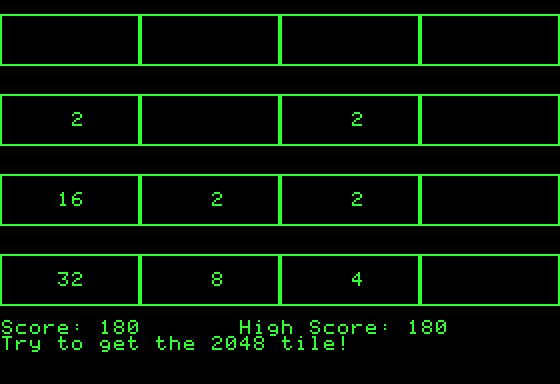Apple2048
This is an implementation of the game "2048" for the Apple // series. It requires an enhanced Apple //e, Apple //c or Apple //gs. The binary is a ProDOS system file.
Instructions about how to play are displayed on launch. You can bring up the instructions at any time by pressing the 'h' key.
Implementation Notes:
The game logic is in game.c and I believe it reproduces the basic behaviours of existing 2048 implementations. The code for animating tiles is mostly still written in C in anim.c and is messy. There are lots of opportunities to improve performance in animations.
The way animations work is:
- Text page one is copied to text page two.
- Text page two is displayed.
- The next frame is prepared on text page one.
- Text page one is displayed
- Repeat all of the above for the next frame.
The copying of page one to page two is implemented in assembly. There is a problem with using text page two. The Apple //GS has a "bug" where shadowing of text page two from bank $00 to bank $E0 is not implemented. This lead to the creation of the "Alternate Display Mode" CDA which did this shadowing in software at a performance cost. Because I am using page two, early versions required "Alternate Display Mode" to be on.
But, I worked around this in software. At startup, the code detects if it is running on a GS. If so, it choses to use a different implementation of the assembly routine to copy from page one to page two. This implementation switches to native 16-bit mode and does a copy from $000400 (text page one) to $E00800 (text page two) right into the $E0 bank. This avoids the need for shadowing $00 to $E0 and it now works as expected on a GS even with "Alternate Display Mode" off.
Possible Improvements:
- Make the animation code not suck so much.
- Optimize the tile drawing code
- Wait for the VBL interval before switching text pages to avoid any tearing.
